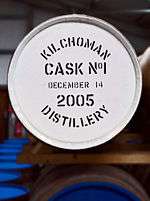Cask strength
Cask strength (also known as barrel proof/barrel strength) is a term used by whiskey (also spelled whisky – viz., the Scots spell it whisky, while the Irish spell it whiskey) producers to describe a whiskey that has not been substantially diluted after its storage in a cask for maturation. The level of alcohol-by-volume (ABV) strength for a cask strength whiskey is typically in the range of 52–66% ABV.[1]

Most bottled whiskey is diluted with water to reduce its strength (i.e., ABV level) to a level that makes it less expensive to produce and more palatable to most consumers – usually about 40% ABV, which is the statutory minimum in some countries, including the United States. The degree of dilution significantly affects the flavor and general drinking experience of the whiskey.
Production
Cask strength is not the highest proof for a whiskey. Still-strength whiskey is typically a higher proof. Whiskey produced by a pot still increases in strength with each distillation and is typically distilled to about 70% ABV, and column stills are capable of producing much higher proof levels. Most distillers reduce the proof by adding water to the whiskey prior to casking it.
The proof level tends to change somewhat during the aging process, depending on storage conditions.[2] Scotch whisky is typically aged in used barrels, and due to the relatively cool climate in Scotland, the proof level typically stays the same or goes down during maturation.[1] In contrast, American bourbon whiskey is produced using new barrels, and storage conditions in Kentucky and Tennessee where nearly all of it is produced allow the proof levels to rise during aging.[1]
The vast majority of whiskey bottled has been watered down to about 40–46% ABV, although some whiskies marketed for whiskey enthusiasts are bottled at proof levels all the way up to cask strength.[3][4]
In the United States, the use of various terms, including "barrel proof", on product labels is regulated by truth in labeling requirements. Under ruling 79-9 of the U.S. Bureau of Alcohol, Tobacco and Firearms, a whiskey can only be called "barrel proof" if the bottling proof is not less than 1% (2 degrees U.S. proof) lower than when the barrels were dumped at the end of the aging period.(ref 5 link broken: text seems to contradict the regulation cited at https://www.ttb.gov/images/pdfs/rulings/79-9.htm )[1][5] The ruling also covers the use of several other phrases describing high-proof whiskies. The phrases "original proof", "original barrel proof", and "entry proof" are restricted to "indicate that the proof of the spirits entered into the barrel and the proof of the bottled spirits are the same".[5]
Drinking
Consumers often add water to cask strength whiskies in order to reduce the "heat" – the "burn" sensation that goes with the drinking experience – and bring out different whiskey flavors. Diluting the whiskey with varying amounts of water will modify the flavor profile, and some consumers like to have control over that. Some add water to the whiskey, while others add ice. The water and temperature affect the taste of the whiskey, and the selection of water is also important. Aficionados suggest using mineral water rather than ordinary tap water, and some even distinguish among different mineral water selections.[6]
References
- Cowdery, Charles K. (Summer 2018). "The Basics of Barrel Proof". Whiskey Advocate. p. 35.
- Whittaker, G. Clay. "How to Drink a Cask Strength Whiskey". Men's Journal. Retrieved July 14, 2017.
- https://stilnovisti.com/news/cs-sc-non-chill-filtered-how-to-read-whisky-labels
- Schrieberg, Felipe (November 28, 2016). "5 Cask Strength Whiskies That Give You A Serious Bang For Your Buck". Forbes. Retrieved July 14, 2017.
- "ATF Ruling 79-9". U.S. Alcohol and Tobacco Tax and Trade Bureau. Retrieved August 29, 2018.
- Nouet, Martine (February 23, 2017). "Why I Dislike Cask Strength Whiskey". Retrieved July 14, 2017.
Additional sources
- Directive 87/250/EEC, 15 March 1987.